
Firs are evergreen coniferous trees belonging to the genus Abies in the family Pinaceae. There are approximately 48–65 extant species, found on mountains throughout much of North and Central America, Europe, Asia, and North Africa. The genus is most closely related to Keteleeria, a small genus confined to eastern Asia.
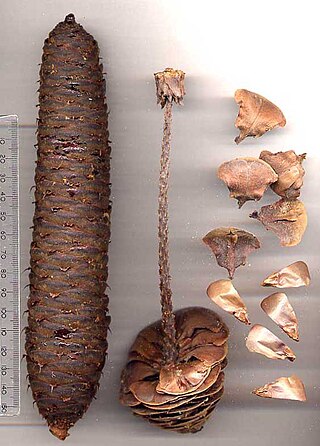
Abies × borisii-regis is a hybrid species of fir native to the mountains of the Balkan Peninsula in Bulgaria, northern Greece, Kosovo, North Macedonia, Albania and Serbia. It occurs at altitudes of 800–1,800 m (2,600–5,900 ft), on mountains with an annual rainfall of over 1,000 mm (39 in).

Abies bracteata, the Santa Lucia fir or bristlecone fir, is the rarest fir in North America, and according to some, the world. It is confined to steep-sided slopes and the bottoms of rocky canyons in the Santa Lucia Mountains, in the Big Sur region on the central coast of California, United States.
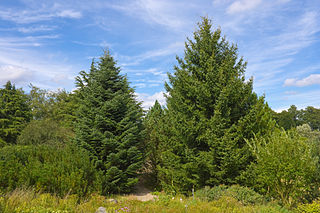
Abies cephalonica or Greek fir is a fir native to the mountains of Greece, primarily in the Peloponnesos and the island of Kefallonia, intergrading with the closely related Bulgarian fir further north in the Pindus mountains of northern Greece. It is a medium-size evergreen coniferous tree growing to 25–35 metres (82–115 ft) – rarely 40 m (130 ft) – tall and with a trunk diameter of up to 1 m. It occurs at altitudes of 900–1,700 m (3,000–5,600 ft), on mountains with a rainfall of over 1,000 millimetres (39 in).

Abies nebrodensis, the Sicilian fir, is a fir native to the Madonie mountains in northern Sicily.

Pseudolarix amabilis is a species of coniferous tree in the pine family Pinaceae. The species is commonly known as golden larch, but being more closely related to Keteleeria, Abies and Cedrus, is not a true larch (Larix). P. amabilis is native to eastern China, occurring in small areas in the mountains of southern Anhui, Zhejiang, Fujian, Jiangxi, Hunan, Hubei and eastern Sichuan, at altitudes of 100–1,500 m (328–4,921 ft). The earliest known occurrences are of compression fossils found in the Ypresian Allenby Formation and mummified fossils found in the Late Eocene Buchanan Lake Formation on Axel Heiberg Island.

Abies grandis is a fir native to northwestern North America, occurring at altitudes of sea level to 1,700 metres (5,600 ft). It is a major constituent of the Grand Fir/Douglas Fir Ecoregion of the Cascade Range.

Pseudolarix is a genus of coniferous trees in the pine family Pinaceae containing three species, the extant Pseudolarix amabilis and the extinct species Pseudolarix japonica and Pseudolarix wehrii. Pseudolarix species are commonly known as golden larch, but are not true larches (Larix) being more closely related to Keteleeria, Abies and Cedrus. P. amabilis is native to eastern China, occurring in small areas in the mountains of southern Anhui, Zhejiang, Fujian, Jiangxi, Hunan, Hubei and eastern Sichuan, at altitudes of 100–1,500 m (328–4,921 ft). P. wehrii is described from fossils dating to the Early Eocene (Ypresian), of Western North America where it is found in the Eocene Okanagan Highlands Allenby and Klondike Mountain Formations. The youngest known occurrence is of mummified fossils found in the Late Eocene Buchanan Lake Formation on Axel Heiberg Island. P. japonica is known from Middle Miocene to Pliocene sediments in Japan and Miocene deposits of Korea. Fossils assigned to Pseudolarix as a genus date possibly as old as the Early Cretaceous Hauterivian stage in Mongolia.
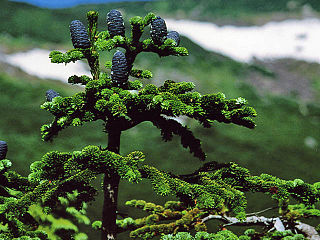
Abies mariesii, also known as Maries' fir, is a species of fir native to the mountains of central and northern Honshū, Japan. It grows at altitudes of 750–1,900 m in northern Honshū, and 1,800–2,900 m in central Honshū, always in temperate rain forest with high rainfall and cool, humid summers, and very heavy winter snowfall.
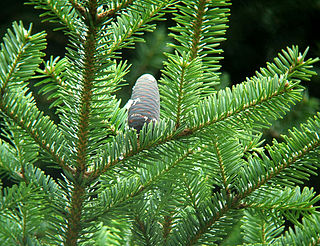
Abies homolepis, also known as the Nikko fir, is a species of fir native to the mountains of central and southern Honshū and Shikoku, Japan. It grows at altitudes of 700–2,200 m, often in temperate rain forest with high rainfall and cool, humid summers, and heavy winter snowfall.
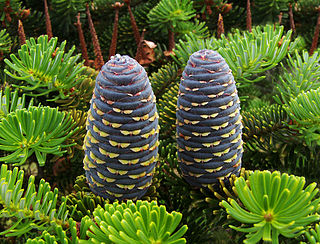
Abies koreana, the Korean fir, is a species of fir native to the higher mountains of South Korea, including Jeju Island. It grows at altitudes of 1,000–1,900 metres (3,300–6,200 ft) in temperate rainforest with high rainfall and cool, humid summers, and heavy winter snowfall.

Abietoideae is a subfamily of the conifer family Pinaceae. The name is from the genus Abies (firs), which contains most of the species in the genus. Six genera are currently assigned to this subfamily: Abies, Cedrus, Keteleeria, Nothotsuga, Pseudolarix, and Tsuga.

Abies firma, the momi fir, is a species of fir native to central and southern Japan, growing at low to moderate altitudes of 50–1200 m.

Abies religiosa, the oyamel fir or sacred fir, is a fir native to the mountains of central and southern Mexico and western Guatemala. It grows at high elevations of 2,100–4,100 metres (6,900–13,500 ft) in cloud forests with cool, humid summers and dry winters in most of its habitat regime. In the state of Veracruz, it grows with precipitation all year long. The tree is resistant to regular winter snowfalls.
Neoephemera antiqua is an extinct species of square-gill mayfly in the family Neoephemeridae that is known from early Eocene, Ypresian stage, lake deposits near the small community of Republic in Ferry County, Washington, USA.

Coryloides is an extinct genus of flowering plants in the hazelnut family, Betulaceae, containing the single species Coryloides hancockii. The species is solely known from the middle Eocene sediments exposed in north central Oregon and was first described from a series of isolated fossil nuts in cherts.
Paraconcavistylon is an extinct genus of flowering plant in the family Trochodendraceae comprises a single species, Paraconcavistylon wehrii. The genus is known from fossil fruits and leaves found in the early Eocene deposits of northern Washington state, United States, and southern British Columbia, Canada. The species was initially described as a member of the related extinct genus Concavistylon as "Concavistylon" wehrii, but subsequently moved to the new genus Paraconcavistylon in 2020 after additional study.
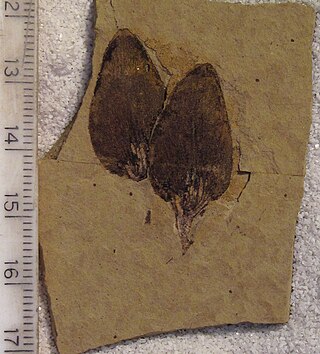
Pseudolarix wehrii is an extinct species of golden larch in the pine family (Pinaceae). The species is known from early Eocene fossils of northern Washington state, United States, and southern British Columbia, Canada, along with late Eocene mummified fossils found in the Qikiqtaaluk Region, Nunavut, Canada.

Carpinus perryae is an extinct species of hornbeam known from fossil fruits found in the Klondike Mountain Formation deposits of northern Washington state, dated to the early Eocene Ypresian stage. Based on described features, C. perryae is the oldest definite species in the genus Carpinus.

Pteronepelys, sometimes known as the winged stranger, is an extinct genus of flowering plant of uncertain affinities, which contains the one species, Pteronepelys wehrii. It is known from isolated fossil seeds found in middle Eocene sediments exposed in north central Oregon and Ypresian-age fossils found in Washington, US.

















